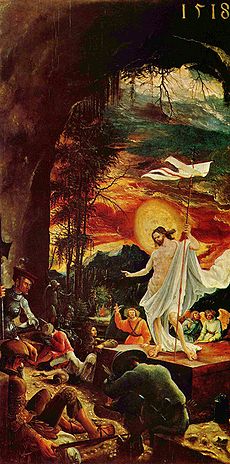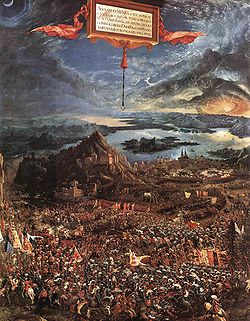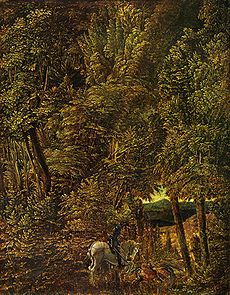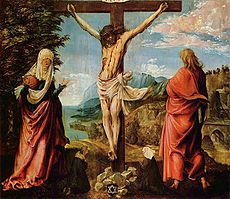
Albrecht Altdorfer
Encyclopedia

Architect
An architect is a person trained in the planning, design and oversight of the construction of buildings. To practice architecture means to offer or render services in connection with the design and construction of a building, or group of buildings and the space within the site surrounding the...
of the Renaissance
Renaissance
The Renaissance was a cultural movement that spanned roughly the 14th to the 17th century, beginning in Italy in the Late Middle Ages and later spreading to the rest of Europe. The term is also used more loosely to refer to the historical era, but since the changes of the Renaissance were not...
era.
Biography
Altdorfer was born in RegensburgRegensburg
Regensburg is a city in Bavaria, Germany, located at the confluence of the Danube and Regen rivers, at the northernmost bend in the Danube. To the east lies the Bavarian Forest. Regensburg is the capital of the Bavarian administrative region Upper Palatinate...
or Altdorf
Altdorf
Altdorf may refer to: In Switzerland:*Altdorf, Switzerland, the capital of the canton of Uri , *Altdorf, Schaffhausen, a village in the canton of Schaffhausen ,...
around 1480.
He acquired an interest in art from his father, Ulrich Altdorfer, who was a painter and miniaturist. At the start of his career, he won public attention by creating small, intimate modestly scaled works in unconventional media and with eccentric subject matter. He settled in the free imperial city
Free Imperial City
In the Holy Roman Empire, a free imperial city was a city formally ruled by the emperor only — as opposed to the majority of cities in the Empire, which were governed by one of the many princes of the Empire, such as dukes or prince-bishops...
of Regensburg, a town located on the Danube River in 1505, eventually becoming the town architect and a town councillor. His first signed works date to c. 1506, including engravings and drawings such the Stygmata of St. Francis and St. Jerome. His models were niello
Niello
Niello is a black mixture of copper, silver, and lead sulphides, used as an inlay on engraved or etched metal. It can be used for filling in designs cut from metal...
s and copper engravings from the workshops of Jacopo de Barbari and Albrecht Dürer
Albrecht Dürer
Albrecht Dürer was a German painter, printmaker, engraver, mathematician, and theorist from Nuremberg. His prints established his reputation across Europe when he was still in his twenties, and he has been conventionally regarded as the greatest artist of the Northern Renaissance ever since...
.
Around 1511 or earlier, he travelled down the river and south into the Alps, where the scenery moved him so deeply that he became the first landscape painter in the modern sense, making him the leader of the Danube School
Danube school
The Danube School or Donau School is the name of a circle of painters of the first third of the 16th century in Bavaria and Austria . Many also were innovative printmakers, usually in etching...
, a circle that pioneered landscape as an independent genre, in southern Germany
Germany
Germany , officially the Federal Republic of Germany , is a federal parliamentary republic in Europe. The country consists of 16 states while the capital and largest city is Berlin. Germany covers an area of 357,021 km2 and has a largely temperate seasonal climate...
. From 1513 he was at the service of Maximilian I
Maximilian I, Holy Roman Emperor
Maximilian I , the son of Frederick III, Holy Roman Emperor and Eleanor of Portugal, was King of the Romans from 1486 and Holy Roman Emperor from 1493 until his death, though he was never in fact crowned by the Pope, the journey to Rome always being too risky...
in Innsbruck
Innsbruck
- Main sights :- Buildings :*Golden Roof*Kaiserliche Hofburg *Hofkirche with the cenotaph of Maximilian I, Holy Roman Emperor*Altes Landhaus...
, where he received several commission from the imperial court. During the turmoil of the Protestant Reformation
Protestant Reformation
The Protestant Reformation was a 16th-century split within Western Christianity initiated by Martin Luther, John Calvin and other early Protestants. The efforts of the self-described "reformers", who objected to the doctrines, rituals and ecclesiastical structure of the Roman Catholic Church, led...
, he dedicated mostly to architecture; paintings of the period, showing his increasing attention to architecture, include the Nativity of the Virgin
Nativity of the Virgin (Altdorfer)
The Nativity of the Virgin is a painting by the German Renaissance artist Albrecht Altdorfer, dating to c. 1520, which is currently housed in the Alte Pinakothek of Munich, Germany.-Description:...
.
In 1529 he executed The Battle of Alexander at Issus
The Battle of Alexander at Issus
The Battle of Alexander at Issus is a 1529 oil painting by the German artist Albrecht Altdorfer , a pioneer of landscape art and a founding member of the Danube school...
for Duke William IV of Bavaria. In the 1520s he returned to Regensburg as a wealth man, and become a member of the city's council. He was also responsible of the fortifications of Regensburg.
In that period his works are influenced by artists such as Giorgione
Giorgione
Giorgione was a Venetian painter of the High Renaissance in Venice, whose career was cut off by his death at a little over thirty. Giorgione is known for the elusive poetic quality of his work, though only about six surviving paintings are acknowledged for certain to be his work...
and Lucas Cranach
Lucas Cranach
Lucas Cranach may refer to:*Lucas Cranach the Elder *Lucas Cranach the Younger...
, as shown by his Crucifixion. In 1535 he was in Vienna
Vienna
Vienna is the capital and largest city of the Republic of Austria and one of the nine states of Austria. Vienna is Austria's primary city, with a population of about 1.723 million , and is by far the largest city in Austria, as well as its cultural, economic, and political centre...
, where he painted the small panel of St. George in the Forest (Laubwald mit dem Heiligen Georg).
He died at Regensburg
Regensburg
Regensburg is a city in Bavaria, Germany, located at the confluence of the Danube and Regen rivers, at the northernmost bend in the Danube. To the east lies the Bavarian Forest. Regensburg is the capital of the Bavarian administrative region Upper Palatinate...
in 1538.
The remains of Altdorfer's surviving work comprises 55 panels, 120 drawings, 125 woodcuts, 78 engravings, 36 etchings, 24 paintings on parchment and fragments from a mural for the bathhouse of the Kaiserhof in Regensburg. This production extends at least over the period 1504-1537. He signed and dated each one of his works.
Painting
Altdorfer was the pioneer painter of pure landscape, making them the subject of the painting, as well as compositions dominated by their landscape. He believed that the human figure shouldn't disrupt nature, but rather participate in it or imitate its natural processes. Taking and developing the landscape style of Lucas Cranach the ElderLucas Cranach the Elder
Lucas Cranach the Elder , was a German Renaissance painter and printmaker in woodcut and engraving...
, he shows the hilly landscape of the Danube valley with thick forests of drooping and crumbling firs and larches hung with moss, and often dramatic colouring from a rising or setting sun. His Landscape with Footbridge (National Gallery, London
National Gallery, London
The National Gallery is an art museum on Trafalgar Square, London, United Kingdom. Founded in 1824, it houses a collection of over 2,300 paintings dating from the mid-13th century to 1900. The gallery is an exempt charity, and a non-departmental public body of the Department for Culture, Media...
) of 1518-1520 is claimed to be the first pure landscape in oil. In this painting, Altdorfer places a large tree that is cut off by the margins at the center of the landscape, making it the central axis and focus within the piece. He uses anthropomorphism to give the tree human qualities such as the drapery of its limbs. He also made many fine finished drawings, mostly landscapes, in pen and watercolour such as the Landscape with the Woodcutter in 1522. The drawing opens at ground level on a clearing surrounding an enormous tree that is placed in the center, dominating the picture. It poses and gesticulates as if it was human, splaying its branches out in every corner. Halfway up the tree trunk, hangs a gabled shrine. At the time, a shrine like this might shelter an image of the Crucifixion or the Virgin Mary, but since it is turned away from the viewer, we are not sure what it truly is. At the bottom of the tree, a tiny figure of a seated man, crossed legged, holds a knife and axe, declaring his status in society/occupation.
Also, he often painted scenes of historical and biblical subjects, set in atmospheric landscapes. His best religious scenes are intense, with their glistening lights and glowing colours sometimes verging on the expressionistic. They often depict moments of intimacy between Christ and his mother, or various saints. His sacral masterpiece and one of the most famous religious works of art of the later Middle Ages
Middle Ages
The Middle Ages is a periodization of European history from the 5th century to the 15th century. The Middle Ages follows the fall of the Western Roman Empire in 476 and precedes the Early Modern Era. It is the middle period of a three-period division of Western history: Classic, Medieval and Modern...
is The Legend of St. Sebastian and The Passion of Christ of the so called Sebastian Altar in St. Florian's Priory
St. Florian's Priory
St. Florian's Priory is a monastery in the town of Sankt Florian, Upper Austria, Austria.-History:The monastery, named after Saint Florian, was founded in the Carolingian period. From 1071 it has housed a community of Augustinian Canons, and is thus is one of the oldest operational monasteries in...
(Stift Sankt Florian) near Linz
Linz
Linz is the third-largest city of Austria and capital of the state of Upper Austria . It is located in the north centre of Austria, approximately south of the Czech border, on both sides of the river Danube. The population of the city is , and that of the Greater Linz conurbation is about...
, Upper Austria
Upper Austria
Upper Austria is one of the nine states or Bundesländer of Austria. Its capital is Linz. Upper Austria borders on Germany and the Czech Republic, as well as on the other Austrian states of Lower Austria, Styria, and Salzburg...
. When closed the altarpiece displayed the four panels of the legend of St. Sebastian’s Martyrdom, while the opened wings displayed the Stations of the Cross
Stations of the Cross
Stations of the Cross refers to the depiction of the final hours of Jesus, and the devotion commemorating the Passion. The tradition as chapel devotion began with St...
. Today the altarpiece is dismantled and the predella
Predella
A predella is the platform or step on which an altar stands . In painting, the predella is the painting or sculpture along the frame at the bottom of an altarpiece...
s depicting the two final scenes, Entombment and Resurrection
Resurrection
Resurrection refers to the literal coming back to life of the biologically dead. It is used both with respect to particular individuals or the belief in a General Resurrection of the dead at the end of the world. The General Resurrection is featured prominently in Jewish, Christian, and Muslim...
were sold to Kunsthistorisches Museum
Kunsthistorisches Museum
The Kunsthistorisches Museum is an art museum in Vienna, Austria. Housed in its festive palatial building on Ringstraße, it is crowned with an octagonal dome...
in Vienna
Vienna
Vienna is the capital and largest city of the Republic of Austria and one of the nine states of Austria. Vienna is Austria's primary city, with a population of about 1.723 million , and is by far the largest city in Austria, as well as its cultural, economic, and political centre...
in 1923 and 1930. Both these paintings share a similar formal structure that consists of an open landscape that is seen beyond and through the opening of a dark grotto. The date of completion on the resurrection panel is 1518.
Altdorfer often distorts perspective to subtle effect. His donor figures are often painted completely out of scale with the main scene, as in paintings of the previous centuries. He also painted some portraits; overall his painted oeuvre was not large. In his later works, Altdorfer moved more towards mannerism and began to depict the human form to the conformity of the Italian model, as well as dominate the picture with frank colors.
Paintings in Munich

The Battle of Alexander at Issus
The Battle of Alexander at Issus is a 1529 oil painting by the German artist Albrecht Altdorfer , a pioneer of landscape art and a founding member of the Danube school...
(or of Alexander) of 1529 was commissioned by William IV, Duke of Bavaria
William IV, Duke of Bavaria
William IV of Bavaria was Duke of Bavaria from 1508 to 1550, until 1545 together with his younger brother Louis X, Duke of Bavaria....
as part of a series of eight historical battle scenes destined to hang in the Residenz in Munich. If ever a work of art merited comparison with epic poetry, "The Battle of Issus" is it. Albrecht Altdorfer's depiction of the moment in 333 BC when Alexander the Great routed Darius III for supremacy in Asia Minor is vast in ambition, sweeping in scope, vivid in imagery, rich in symbols, and obviously heroic—the Iliad of painting, as literary critic Friedrich Schlegel suggested In the painting, a swarming cast of thousands of soldiers surround the central action: Alexander on his white steed, leading two rows of charging cavalrymen, dashes after a fleeing Darius, who looks anxiously over his shoulder from a chariot. The opposing armies are distinguished by the colors of their uniforms: Darius' army in red and Alexander's in blue. The upper half of The Battle of Alexander expands with unreal rapidity into an arcing panorama comprehending vast coiling tracts of globe and sky. The victory also lies on the planar surface; The sun outshone the moon just as the Imperial and allied army successfully repel the Turks
By making the mass number of soldiers blend within the landscape/painting, it shows that he believed that the usage and depiction of landscape was just as significant as a historical event, such as a war. He renounced the office of Major of Regensburg to accept the commission. Few of his other paintings resemble this apocalyptic scene of two huge armies dominated by an extravagant landscape seen from a very high viewpoint, which looks south over the whole Mediterranean from modern Turkey to include the island of Cyprus
Cyprus
Cyprus , officially the Republic of Cyprus , is a Eurasian island country, member of the European Union, in the Eastern Mediterranean, east of Greece, south of Turkey, west of Syria and north of Egypt. It is the third largest island in the Mediterranean Sea.The earliest known human activity on the...
and the mouths of the Nile
Nile
The Nile is a major north-flowing river in North Africa, generally regarded as the longest river in the world. It is long. It runs through the ten countries of Sudan, South Sudan, Burundi, Rwanda, Democratic Republic of the Congo, Tanzania, Kenya, Ethiopia, Uganda and Egypt.The Nile has two major...
and the Red Sea
Red Sea
The Red Sea is a seawater inlet of the Indian Ocean, lying between Africa and Asia. The connection to the ocean is in the south through the Bab el Mandeb strait and the Gulf of Aden. In the north, there is the Sinai Peninsula, the Gulf of Aqaba, and the Gulf of Suez...
(behind the isthmus to the left) on the other side. However his style here is a development of that of a number of miniatures of battle-scenes he had done much earlier for Maximilian I
Maximilian I, Holy Roman Emperor
Maximilian I , the son of Frederick III, Holy Roman Emperor and Eleanor of Portugal, was King of the Romans from 1486 and Holy Roman Emperor from 1493 until his death, though he was never in fact crowned by the Pope, the journey to Rome always being too risky...
in his illuminated manuscript
Illuminated manuscript
An illuminated manuscript is a manuscript in which the text is supplemented by the addition of decoration, such as decorated initials, borders and miniature illustrations...
Triumphal Procession in 1512-14. It is thought to be the earliest painting to show the curvature of the Earth from a great height.
The Battle is now in the Alte Pinakothek
Alte Pinakothek
The Alte Pinakothek is an art museum situated in the Kunstareal in Munich, Germany. It is one of the oldest galleries in the world and houses one of the most famous collections of Old Master paintings...
, which has the best collection of Altdorfer's paintings, including also his small St. George and the Dragon (1510), in oil on parchment
Parchment
Parchment is a thin material made from calfskin, sheepskin or goatskin, often split. Its most common use was as a material for writing on, for documents, notes, or the pages of a book, codex or manuscript. It is distinct from leather in that parchment is limed but not tanned; therefore, it is very...
, where the two figures are tiny and almost submerged in the lush, dense forest that towers over them. Altdorfer seems to exaggerate the measurements of the forest in comparison to the figures: the leaves appear to be larger than the horse, showing the significance of nature and landscape. He also emphasizes line within the work, by displaying the upward growth of the forest with the vertical and diagonal lines of the trunks. There is a small opening of the forest on the lower right hand corner that provides a rest for your eyes. It serves to create depth within the painting and is the only place you can see the characters. The human form is completely absorbed by the thickness of the forest. Fantastic light effects provide a sense of mystery and dissolve the outline of objects. Without the contrast of light, the figures would blend in with its surrounding environment. Altdorfer's figures are invariably the complement of his romantic landscapes; for them he borrowed Albrecht Dürer
Albrecht Dürer
Albrecht Dürer was a German painter, printmaker, engraver, mathematician, and theorist from Nuremberg. His prints established his reputation across Europe when he was still in his twenties, and he has been conventionally regarded as the greatest artist of the Northern Renaissance ever since...
's inventive iconography, but the panoramic setting is personal and has nothing to do with the fantasy landscapes of the Netherlands A Susanna in the Bath and the Stoning of the Elders (1526) set outside an Italianate skyscraper of a palace shows his interest in architecture. Another small oil on parchment, Danube Landscape with Castle Wörth (c. 1520) is one of the earliest accurate topographical paintings of a particular building in its setting, of a type that was to become a cliché in later centuries.
Printmaking

Engraving
Engraving is the practice of incising a design on to a hard, usually flat surface, by cutting grooves into it. The result may be a decorated object in itself, as when silver, gold, steel, or glass are engraved, or may provide an intaglio printing plate, of copper or another metal, for printing...
s and about ninety-three woodcut
Woodcut
Woodcut—occasionally known as xylography—is a relief printing artistic technique in printmaking in which an image is carved into the surface of a block of wood, with the printing parts remaining level with the surface while the non-printing parts are removed, typically with gouges...
s. These included some for the Triumphs of Maximilian, where he followed the overall style presumably set by Hans Burgkmair
Hans Burgkmair
Hans Burgkmair the elder was a German painter and printmaker in woodcut.Burgkmair was born in Augsburg, the son of painter Thomas Burgkmair and his son, Hans the Younger, became one too. From 1488 he was a pupil of Martin Schongauer in Colmar, who died during his two years there, before Burgkmair...
, although he was able to escape somewhat from this in his depictions of the more disorderly baggage-train, still coming through a mountain landscape. However most of his best prints
Old master print
An old master print is a work of art produced by a printing process within the Western tradition . A date of about 1830 is usually taken as marking the end of the period whose prints are covered by this term. The main techniques concerned are woodcut, engraving and etching, although there are...
are etching
Etching
Etching is the process of using strong acid or mordant to cut into the unprotected parts of a metal surface to create a design in intaglio in the metal...
s, many of landscapes; in these he was able most easily to use his drawing style.http://www.metmuseum.org/toah/hd/intg/ho_1993.1097.htm He was one of the most successful early etchers, and was unusual for his generation of German printmakers in doing no book illustrations. He often combined etching and engraving techniques in a single plate, and produced about 122 intaglio prints altogether.
Public life
As the superintendent of the municipal buildings Altdorfer had overseen the construction of several commercial structures, such as a slaughterhouse and a building for wine storage, possibly even designing them. He was considered to be an outstanding politician of his day. In 1517 he was a member of the "Ausseren Rates", the council on external affairs, and in this capacity was involved in the expulsion of the Jews, the destruction of the synagogue and in its place the construction of a church and shrine to the Schöne Maria that occurred in 1519. Altdorfer made etchings of the interior of the synagogue and designed a woodcut of the cult image of the Schöne Maria. In 1529-1530 he was also charged with reinforcing certain city fortifications in response to the Turkish threat.Albrecht's brother, Erhard Altdorfer
Erhard Altdorfer
Erhard Altdorfer was a German Early Renaissance printmaker, painter, and architect, who worked as a court painter in Schwerin from 1512 until his death in 1561....
, was also a painter and printmaker in woodcut and engraving, and a pupil of Lucas Cranach the Elder
Lucas Cranach the Elder
Lucas Cranach the Elder , was a German Renaissance painter and printmaker in woodcut and engraving...
.

Further reading
- Alte Pinakotek, Munich; (Summary Catalogue -various authors),1986, Edition Lipp,ISBN 3874907015
- CS Wood, Albrecht Altdorfer and the Origins of Landscape, 1993, Reaktion Books, London, ISBN 0948462469
External links
- Works by Albrecht Altdofer at the Museum of New Zealand Te Papa Tongarewa
- Works by Altdorfer at Zeno.org
- Albrecht Altdorfer in the "History of Art"
- Albrecht Altdorfer Wallpapers
- Page at artcyclopedia.com
- Page at ibiblio.org
- Page at gallery.euroweb.hu
- Artvibrations Archive: http://www.artvibrations.com/AlbrechtAltdorfer
- Albrecht Altdorfer Paintings Gallery (Public Domain Paintings - www.art.onilm.com)

